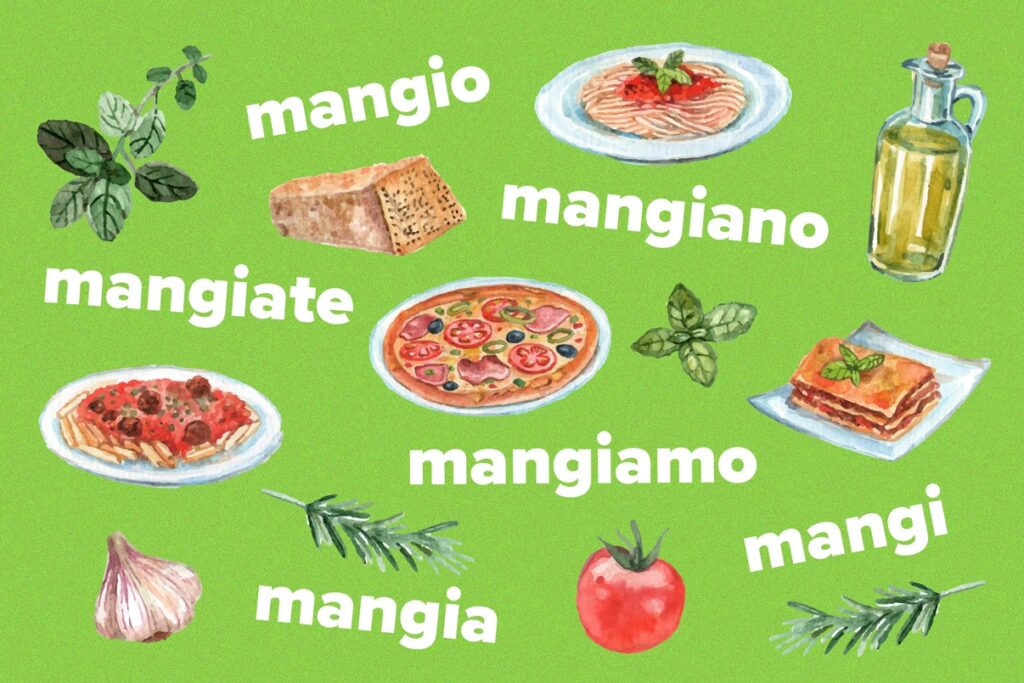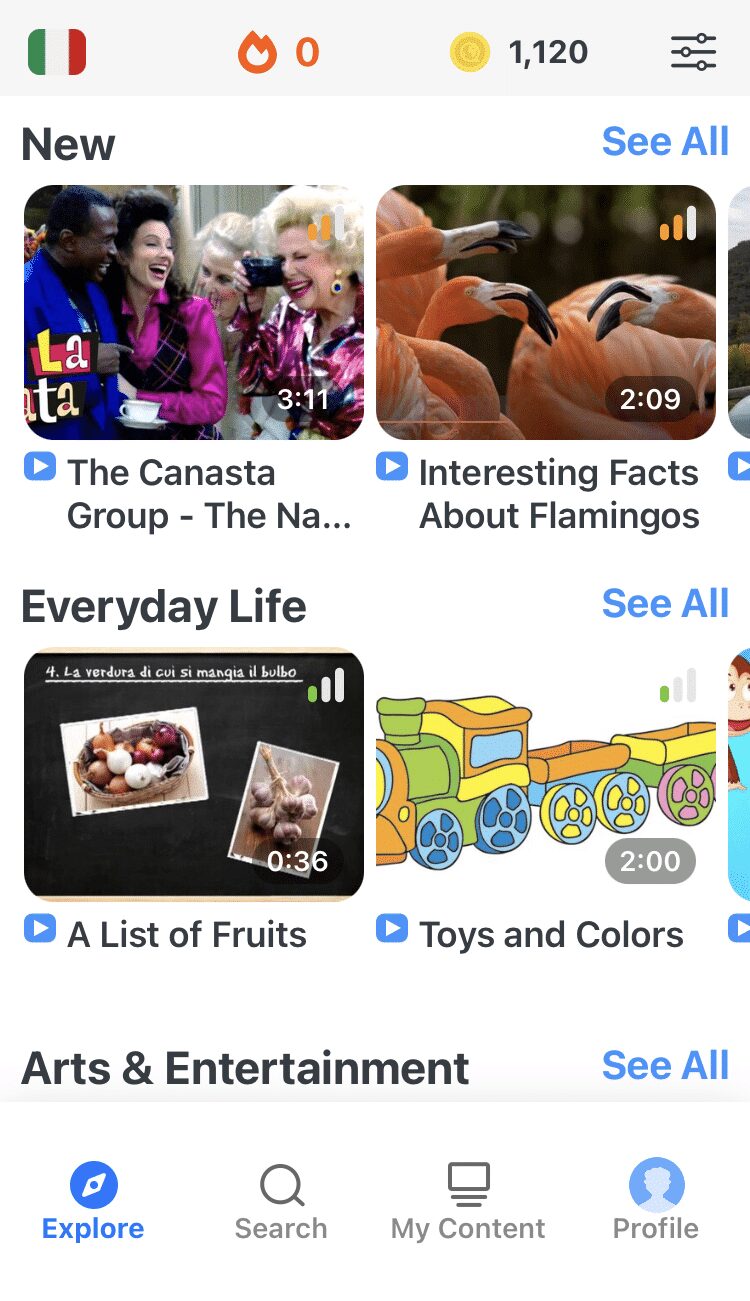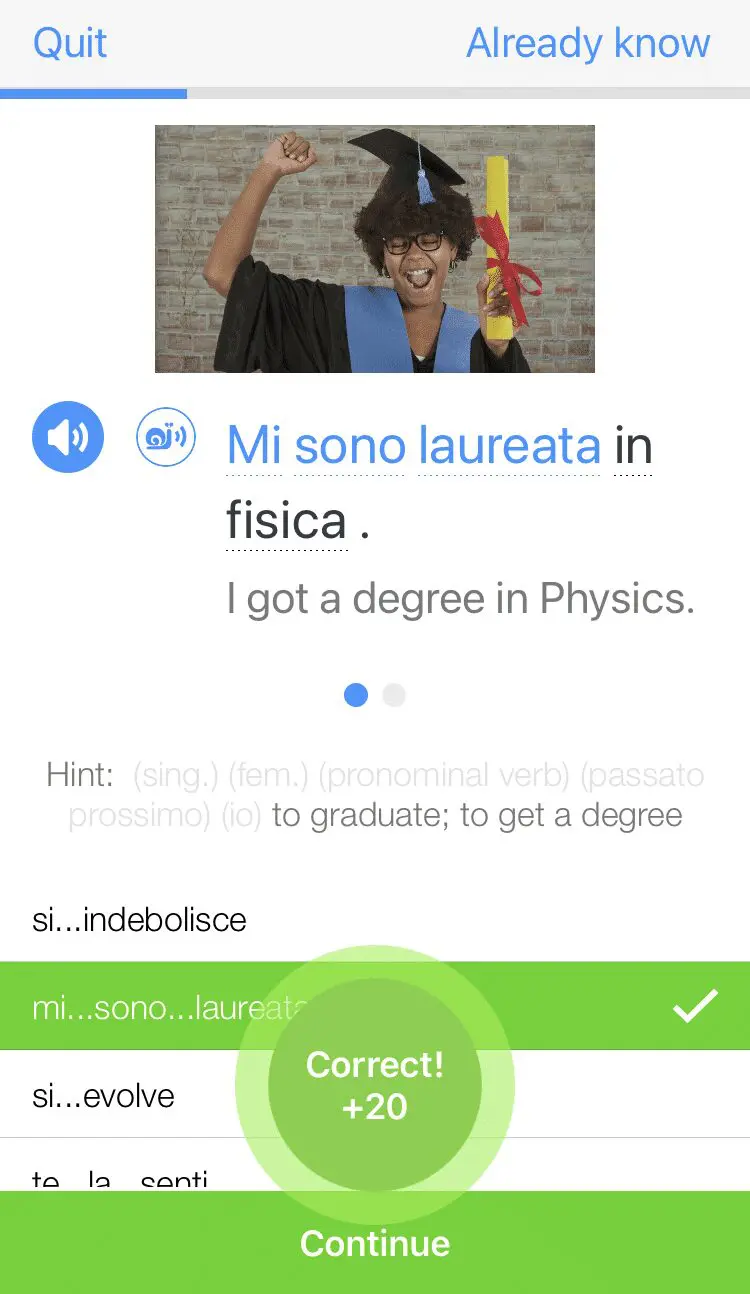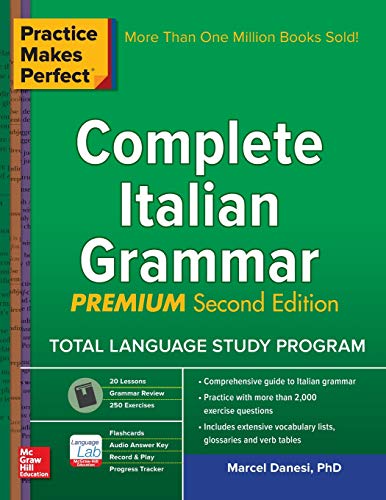Italian Verb Conjugation: The Essential Guide

If you ask former language students where they gave up on learning Italian, or where they thought the end of the road was, it’s here: Italian verb conjugations.
This may sound all too familiar to you, so let’s get you back on track with this post and help you have a healthier attitude on the subject.
Download: This blog post is available as a convenient and portable PDF that you can take anywhere. Click here to get a copy. (Download)
What You Need to Know Before Conjugating
Verb conjugation is when you turn a verb like “run” into “ran” or “running” or “will run.”
In this section, we lay the groundwork and talk about the things that you’re going to use to conjugate verbs.
Italian Pronouns
To correctly conjugate a verb, you need to know who is doing the action.
Specifically, you need to know if they’re in the first person, second person or third person point of view, and whether they’re singular or plural. Why? Because each takes on a different verb form.
Here’s a summary of Italian pronouns:
| Point of View | Meaning | Italian | English |
|---|---|---|---|
| First Person | Used when you’re talking about yourself, your opinions and the things that happened to you. | io | I |
| noi | we | ||
| Second Person | Refers to the person you’re addressing. | tu | you (singular) |
| voi | you (plural) | ||
| Third Person | Refers to the people and objects talked about. | lui | he / it |
| lei | she / it | ||
| esso , essa | it | ||
| loro , essi , esse | they |
A couple of quick notes:
- The English “it” is a special case. You can either use lui, lei or loro depending on what “it” is being replaced. Use lui if the noun being replaced is masculine in gender and lei if it’s feminine.
- Another pronoun you might hear is Lei.
This is the formal “you” in Italian, used for people you’ve just met or people considered higher than you in the ladder of life. In comparison, tu is considered the informal you, used for friends and family.
Lei is different from the lei (she) which has an uncapitalized letter “l,” but it follows the same conjugation rules.
Italian Verb Groups
In the Italian language, verbs can be grouped into three distinct classes based on their endings. (English, on the other hand, is just all over the place.)
These are the three classes of Italian verbs:
| Italian Verb Class | Examples |
|---|---|
| -are | parlare (talk) entrare (enter) nuotare (swim) |
| -ere | scrivere (write) leggere (read) vedere (see) |
| -ire | costruire (build) seguire (follow) colpire (hit) |
We’re talking here about verbs that are in the infinitive form. This is also their simplest form, and it’s the one that’s used as an entry in the dictionary.
In English, “swim” is in the infinitive form. “Swimming” or “swam” are not.
Verbs with the same endings follow the same verb conjugation rules. Watch for the last three letters of the verbs (-are, -ere and -ire) because they’ll usually be dropped and replaced with something else.
In the next section, we’ll look at how those different verbs are conjugated in the most common tenses in Italian.
Conjugation Rules for Common Tenses
The Present Tense: Presente indicativo
Much like it is in English, the Italian present tense is used to talk about habitual actions, basic truths, descriptions and actions happening at the moment of speaking.
-are Verbs
In the present tense, if a verb ends with -are, the -are is dropped. You then add the corresponding ending following this table:
Mangiare (To eat)
| Pronoun | Present Tense | Conjugation Ending |
|---|---|---|
| io (I) | mangio | -o |
| tu (you) | mangi | -i |
| lui / lei (he / she) | mangia | -a |
| noi (we) | mangiamo | -iamo |
| voi (you all) | mangiate | -ate |
| loro (they) | mangiano | -ano |
-ere Verbs
In the present tense, if a verb ends with -ere, the -ere is dropped and changed into the following:
Vivere (to live)
| Pronoun | Present Tense | Conjugation Ending |
|---|---|---|
| io (I) | vivo | -o |
| tu (you) | vivi | -i |
| lui / lei (he / she) | vive | -e |
| noi (we) | viviamo | -iamo |
| voi (you all) | vivete | -ete |
| loro (they) | vivono | -ono |
-ire Verbs
In the present tense, if a verb ends with -ire, the -ire is dropped and changed into the following:
Dormire (to sleep)
| Pronoun | Present Tense | Conjugation Ending |
|---|---|---|
| io (I) | dormo | -o |
| tu (you) | dormi | -i |
| lui / lei (he / she) | dorme | -e |
| noi (we) | dormiamo | -iamo |
| voi (you all) | dormite | -ite |
| loro (they) | dormono | -ono |
The Past Tense: Passato Prossimo
Passato prossimo refers to actions that were done and completed in the past, but that have an effect in the present.
This is a bit of a unique tense because it can be used for both the present perfect and past tenses in English.
The formula for forming the passato prossimo is: conjugated avere / essere + past participle of the main verb
Avere (to have) and essere (to be) are two of the most common helping verbs in Italian, and they’re the only two you’ll need for conjugating the present perfect. But how do you know which to choose? An easy way to start is by remembering that avere is mostly used with transitive verbs, while essere is mostly used with intransitive verbs.
But before we get to conjugating avere and essere, you’ll have to learn how to form the past participle. In general, the past participle ends with -to:
| Verb Type | Past Participle Rule | Example |
|---|---|---|
| -are | Drop the -are and replace it with -ato. | mangiare (eat) → mangiato (eaten) |
| -ere | Drop the -ere and replace it with -uto. | vendere (sell) → venduto (sold) |
| -ire | Drop the -ire and replace it with -ito. | sentire (feel) → sentito (felt) |
Mangiare (to eat): conjugated with auxiliary verb avere
| Pronoun | Present Pefect Tense |
|---|---|
| io (I) | ho mangiato |
| tu (you) | hai mangiato |
| lui / lei (he / she) | ha mangiato |
| noi (we) | abbiamo mangiato |
| voi (you all) | avete mangiato |
| loro (they) | hanno mangiato |
Arrivare (to arrive): conjugated with auxiliary verb essere
| Pronoun | Present Perfect Tense | |
|---|---|---|
| Masculine | Feminine | |
| io (I) | sono arrivato | sono arrivata |
| tu (you) | sei arrivato | sei arrivata |
| lui / lei (he / she) | lui è arrivato | lei è arrivata |
| noi (we) | noi siamo arrivati | noi siamo arrivate |
| voi (you all) | siete arrivati | siete arrivate |
| loro (they) | sono arrivati | sono arrivate |
The Imperfect Tense: L’imperfetto
Use this tense for actions that happened over and over again in the past. If you used to diet and if you used to exercise, but have since stopped, that’s an example of reality acceptance…I mean, l’imperfetto.
-are Verbs
In the imperfect tense, if a verb ends with -are, drop the -are and then add the following:
Mangiare (to eat)
| Pronoun | Imperfect Tense | Conjugation Ending |
|---|---|---|
| io (I) | mangiavo | -avo |
| tu (you) | mangiavi | -avi |
| lui / lei (he / she) | mangiava | -ava |
| noi (we) | mangiavamo | -avamo |
| voi (you all) | mangiavate | -avate |
| loro (they) | mangiavano | -avano |
-ere Verbs
For -ere verbs, the conjugation is almost exactly the same as for -are verbs. You just have to take the -are suffixes and change the a into an e.
Vivere (to live)
| Pronoun | Imperfect Tense | Conjugation Ending |
|---|---|---|
| io (I) | vivevo | -evo |
| tu (you) | vivevi | -evi |
| lui / lei (he / she) | viveva | -eva |
| noi (we) | vivevamo | -evamo |
| voi (you all) | vivevate | -evate |
| loro (they) | vivevano | -evano |
-ire Verbs
Finally, -ire verbs follow the exact same pattern as the two previous verb classes, but this time using an i.
Dormire (to sleep)
| Pronoun | Imperfect Tense | Conjugation Ending |
|---|---|---|
| io (I) | dormivo | -ivo |
| tu (you) | dormivi | -ivi |
| lui / lei (he / she) | dormiva | -iva |
| noi (we) | dormivamo | -ivamo |
| voi (you all) | dormivate | -ivate |
| loro (they) | dormivano | -ivano |
The Future Tense: Futuro semplice
The future tense refers to actions that will be done in the future. Ask a teenager and he’ll give you a bunch of future (and tense!) actions, like: studying, washing the dishes and cleaning his room. But I digress.
-are, -ere and -ire verbs
In the future tense, all three verb classes have the same rules. Just drop the letter “e” of -are, -ere and -ire and then add the following ending:
Mangiare (to eat)
| Pronoun | Imperfect Tense | Conjugation Ending |
|---|---|---|
| io (I) | mangerò | -ò |
| tu (you) | mangerai | -ai |
| lui / lei (he / she) | mangerà | -à |
| noi (we) | mangeremo | -emo |
| voi (you all) | mangerete | -ete |
| loro (they) | mangeranno | -anno |
Those Irregular Verbs!
Getting the rules for the common tenses is challenging enough, but what makes conjugation spicier for language learners is that Italian has many “irregular” verbs that seem to say, “To heck with those rules.” They don’t follow the conjugation patterns and have rules of their own.
There are different “irregulars” for different tenses, and one way of taming them is by familiarizing yourself with these verbs and committing them to memory. For example, the verbs capire (understand), fare (make), andare (go) and potere (can) are irregulars in the present tense.
You don’t really have to memorize all of them. Irregular verbs aren’t made equal. You can just pick the most common ones, like the ones mentioned above, and hammer at them hard. This is a much better use of your time than memorizing every single irregular verb that exists.
Don’t be afraid of irregular verbs. They’re fairly common, and if you immerse yourself in Italian, you’ll meet them soon enough. Speaking of which, how exactly do we master verb conjugations? Here are three tips to get you started.
How to Master Italian Verb Conjugations
You have all the info at your fingertips. Now, how do you remember it all? And, beyond that—how do you use the correct verb in an actual Italian conversation?
1. Give conjugated verbs needed context.
The best way to study verb conjugations is in context. Conjugation charts and multiple-choice quizzes will only get you so far. If you want these verbs to stick in your head, you have to see them within real-life sentences.
Any study material that contains verbs can be re-purposed for learning conjugations. This includes Italian songs, short stories, nursery rhymes and movies. Even the comments sections of Italian YouTubers’ videos can be studied!
One tool for studying Italian verb conjugations in context is FluentU.
FluentU takes authentic videos—like music videos, movie trailers, news and inspiring talks—and turns them into personalized language learning lessons.
You can try FluentU for free for 2 weeks. Check out the website or download the iOS app or Android app.
P.S. Click here to take advantage of our current sale! (Expires at the end of this month.)
2. Write them on walls. Literally and seriously.
Your memory will thank you if you learn things by writing them down. That means writing on paper and by hand.
Write everything from conjugation tables to sample sentences. Write them a lot, from left to right, right to left, top-down, bottom-up. Write them in different ways. Write your notes, annotations, questions. Write your own sentences. Write them on walls that you see every day. Write them on post-it notes. Make a flashcard deck.
You might think it’s a waste of time. And it’s time-consuming, for sure. But this is the kind of thing you need to waste time on.
We’re talking about mastery here, right?
So go ahead, “waste” your time doing this. Wrestle with conjugation tables. Think through example sentences and write them down. There’s a payoff at the end when that last drop of ink leaves your pen and you find yourself conjugating Italian verbs like a master.
3. Say them out loud. Again and again.
You don’t even need somebody to pretend to listen to you as you read sentences out loud. The most important audience is already there: You.
You need to hear yourself speak Italian in order to learn. Try reading what you’ve written in the previous tip. Read these sentences aloud multiple times. You need to hear them over and over. You’ll start to notice that Italian grammar is tightly coordinated.
And by repeating these verbs again and again, you’ll begin to see and hear the patterns in the language. You’ll even notice that they sometimes rhyme. You’ll begin to intuitively know what pronoun goes with what conjugation. Not because you remember it as a rule, but because you’ve heard it so many times.
Over time, your work on verb conjugations will become semi-automatic. That is, instead of being backed by rules, you’ll operate on intuition. You’ll have heard something a thousand times, so you’ll feel sure that such and such is the correct form of a verb.
Common Issues with Italian Verb Conjugations
Granted, the subject of conjugations isn’t easy, and admittedly, Italian is a bit harder than English. But that said, conjugation is still not as hard as it’s made out to be. I think there are three major problems in the approach to the subject:
1. The whole subject is covered too fast.
Many textbooks give a chapter or two to conjugations as if that’s enough. And the lessons, when they’re actually taught, are delivered too fast.
But when you really think about it, you can’t just “okay next please!” conjugations. Realistically, as a second language speaker, you get better at it over time, and it takes years of language usage to master.
You have to give yourself the time to learn it. Take it slow. Marinate in the topic.
Conjugation is a big, fat topic. It’s like a catch-all subject that combines everything you’ve ever learned about Italian grammar—pronouns, tenses, nouns, genders, subject-verb agreement, sentence structure and so on.
2. Conjugations are taught almost without context.
Another mistake language learners make is that they think they can “hack” the subject by memorizing rules and then leaving it at that.
As helpful as conjugation tables are, you’ll forget them quickly unless you also apply conjugation in context.
Context makes things vivid. It’s like seeing things in action. So study verbs in sentences too. Repurpose the language content you’re already using—like songs, rhymes, audiobooks and short stories—for learning conjugation. Read children’s stories while paying attention to how the verbs are used, for example.
3. Mistakes aren’t encouraged.
What is it about this subject that makes grammar sticklers out of the sweetest little boys and girls?
“That’s the wrong form! Quick, burn this sinner at the stake!”
Italian language learners need to chill and cut themselves some slack. Seriously.
Even native speakers bungle every now and then. So don’t judge yourself harshly if you get into a kerfuffle.
Guess what? Native speakers understand you even if you butcher their verbs. (How? Context!) Just try to put yourself in their shoes for a moment. Imagine a kindly non-native English speaker on the subway offers his seat to a struggling old lady by saying, “Please, sitting down.” Do you not understand it? (And do you not wish to rush to the seat, ahead of the old lady?)
Don’t worry about making mistakes. We learn by making plenty of them early on and then weeding them out over time.
So, we’ve come to the end of this post. We’ve learned some really healthy attitudes to take on when we tackle verbal conjugations. Again, nobody’s saying they’re easy, but they don’t have to be any language learner’s nightmare.
If you just take your time, make use of context and allow yourself to commit mistakes, you’ll get the hang of it.
Good luck!
Download: This blog post is available as a convenient and portable PDF that you can take anywhere. Click here to get a copy. (Download)
And One More Thing...
If you're as busy as most of us, you don't always have time for lengthy language lessons. The solution? FluentU!
Learn Italian with funny commericals, documentary excerpts and web series, as you can see here:

FluentU helps you get comfortable with everyday Italian by combining all the benefits of complete immersion and native-level conversations with interactive subtitles. Tap on any word to instantly see an image, in-context definition, example sentences and other videos in which the word is used.

Access a complete interactive transcript of every video under the Dialogue tab, and review words and phrases with convenient audio clips under Vocab.

Once you've watched a video, you can use FluentU's quizzes to actively practice all the vocabulary in that video. Swipe left or right to see more examples of the word you’re on.

FluentU will even keep track of all the Italian words you’re learning, and give you extra practice with difficult words. Plus, it'll tell you exactly when it's time for review. Now that's a 100% personalized experience!
The best part? You can try FluentU for free with a trial.
Start using the FluentU website on your computer or tablet or, better yet, download the FluentU app from the iTunes or Google Play store. Click here to take advantage of our current sale! (Expires at the end of this month.)










